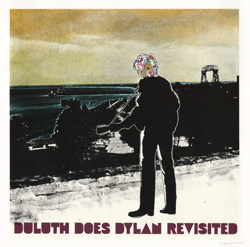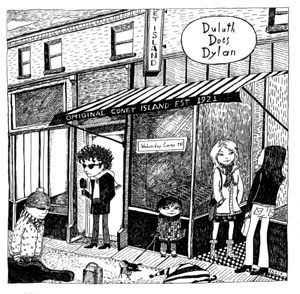Duluth Does Dylan . . . Again:
Chris Godsey reports on the new "Duluth Does Dylan" project, a reprise of the undergroundy original that's got more measure, maturity, and oddity. Release party this Friday (April 7) at the Tap Room in Duluth, and Saturday at the Turf Club in Saint Paul.



Duluth Does Dylan…Again
by Chris Godsey
The morals of this story: owning a recording studio can be more comfortable than renting time in one; even underground rockers and their scenes grow up; a good song is always a good song.
The story behind the morals:
In 2001, multi-disciplinary Duluth entrepreneurs Tim Nelson and Tom Fabjance (who actually lives in Ashland, WI,) released Duluth Does Dylan, a cover-tune tribute to the eponymous local boy made iconic. Most of its tracks are from the happening acts in a tight sector of that era’s local underground music scene.
Production was frenetic, says Fabjance: “We scheduled two days of recording time at a nearby studio. With some strong coffee and some pretty tight scheduling, we were able to record all 15 bands in about 18 hours.”
Those 18 hours yielded an eclectic, accessible, mostly decent batch of tunes that Tim Nelson says has sold about 3,000 copies and been broadly reviewed. “It’s been the biggest in Europe and on the East Coast,” he says. “Dylan fan Web sites were kind to us–most of them wrote favorable review and bought CDs and distributed them through their Web sites.”
CD release shows in Duluth and St. Paul sold out. “People were lined up down the block in front of the Turf Club,” Fabjance says, “to see what the hell all that buzz was coming from the back rooms and basements of Duluth.”
Duluth was buzzing with credibility and momentum, thanks to the Dylan tribute, the growing influence of internationally revered indie band Low, and a scene that incubated such forces. City Pages critic Peter J. Scholtes painted a lovely if limited picture of the scene in “Hey, we’re in Duluth,” which ran on Feb. 7 2001.
And when the hard work and hubbub of Duluth Does Dylan had subsided, Nelson started wondering about doing it all again.
“It was about a year after the first one,” he says. “I thought, ‘Let’s wait till the collection of bands in town rolls over–because it always does in a scene like this.’ Now Dylan’s 65, and he’s still touring, and Duluth is in another moment. There are a whole bunch of new acts, and a lot of them are touring, and Duluth is”–either still or again–“pertinent.”
So just over a year ago, he says, he and Fabjance started putting together Duluth Does Dylan Revisited, which wound up including 15 more covers by none of the same songs or acts, but quite a few of the same people, from the 2001 disc.
Same town. Same general idea. But, Fabjance says, “Different situation. Different scene. Different bands. Tim, myself and Alan Sparhawk now have our own recording studio to work in. Many of the once-new, young bands from the first record no longer exist. The NorShor Theater [once the scene’s clubhouse] has closed. This time around, having our own studio meant we could slow the process down and really take our time.”
According to Sacred Heart Recording Studio Chief Engineer Eric Swanson, who was there for all but one of the acts’ recording sessions, the process was smooth. “It was pretty easy,” he says. “I know all the bands, and quite a few of them had worked at Sacred Heart before.”
Nelson says that Craig Minowa of Cloud Cult recorded much of his band’s track at Earthology, his studio in Moose Lake, and Sparhawk recorded his band Retribution Gospel Choir at 20 Below, his home studio.
“Ha–the co-owner of the studio is one of two people who didn’t record there,” Nelson chuckled while describing the process.
“My presumption was that it would take a while,” he says. “It was a fairly comfortable pace. We had a broad time frame for each song. On the first one, we had less than two hours to do everything–set up, tune, figure out other logistics, and record–for each band. But on this one we told bands, ‘Stop by around 1 p.m., and we’ll see what happens.’ It’s our studio, we’re comfortable with the equipment and the space, and that experience shows.
“I probably invited five or six bands who couldn’t make it, so the lineup evolved throughout the year. Everybody who recorded is on the disc. Once they’ve tracked a song and we’ve mixed it a bit in front of them, I’d feel bad not using it. Plus, everyone on the record is an experienced musician, and they all did a good job.”
Revisited sounds and feels more grown-up than the 2001 disc, which makes sense for various reasons, say Nelson and Swanson.
“There’s more consistency to this one,” Nelson says. “It’s not as diverse, from a listener’s point of view, but that also makes it more cohesive. It’s not a complete picture of the Duluth music scene. I chose to narrow the focus of bands.”
Swanson says, “The people who play on both records have been evolving for five years. This incarnation of the Duluth scene has evolved for about 10 years with many of the same players. With age comes professionalism and awareness. Tim’s done a few compilations [including Iron Country and Chilly Northern Women, both on his Spinout label]. He’s learned how to pick bands and run a whole project. We all have more producing experience.”
Still, he says, “None of this is to say that there aren’t young kids who aren’t represented on this latest Dylan disc who would be more raw. This record represents 15 out of over a hundred bands in town.”
And while the 15 tracks on Revisited do fit within a relatively tight stylistic focus–lots of acoustic strumming, earnest singing, and wisely faithful renditions of Dylan’s originals–there are pleasant surprises: in bold stylistic decisions; in the subtle thrills of hearing familiar songs from new perspectives; and in recognizing Dylan’s genius as it’s channeled through thoughtful interpretations of his familiar and less-familiar work.
No track is terrible, though some–Retribution Gospel Choir’s “All the Tired Horses,” Boy Girl Boy Girl’s “Lay Lady Lay,” Cloud Cult’s “Mr. Tambourine Man,” and maybe the State Champs’ “Oxford Town”–might challenge listeners.
Cloud Cult’s track, especially, could put off or piss off lots of folks, especially Dylan dogmatists. It’s constructed almost completely of swirling, bumping, twitching electronic layers, complemented by bits of acoustic guitar, piano, and cello, with Minowa’s vaguely British-affected vocals floating in and around all those other sounds. Purists and musical Luddites who defensively prefer the Byrds’ jangly 1965 folk-rock-hit rendition should listen to this one carefully and without technological prejudice, because it’s superior at conveying the song’s eerie, definitive melancholy. Minowa’s intonation–probably less pretentious and affected than Roger McGuinn’s–perfectly conveys Dylan’s detached, dream-sensation lyrics. The production–as is the Byrds’ song–is a masterful exercise in distracting attention from its own ominous undercurrent.
Piedmont blues singer and guitarist Charlie Parr’s “Blind Willie McTell”–simple and anguished and suggesting violence–might be the best Revisited track. Parr usually accompanies himself on acoustic or, as he does here, National steel guitar. He sings (and looks the part of) blues hollers and traditional songs and styles that came to this country hundreds of years ago. Both his voice and his playing, gorgeous in their aggressive skill and imperfections, deserve an attention they seldom get in his usual venues; hearing him well-produced and nuanced and in powerful form is a thrill.
Tracks by the Hobo Nephews of Uncle Frank, Jerree Small, and Sara Softich are all worth paragraphs of equal length and celebration, but they’re better experienced than described.
In late March, Nelson–who’s also put together Iron Country and Chilly Northern Women, both available on Spinout–said he was done with compilation CDs for a while. “Watching the Scorsese documentary No Direction Home changed my life,” he said. “Dylan is a genius, partially because he’s so focused. He’s a songwriter, so he writes songs. I was watching that movie and I thought, ‘I’ve gotta stop spreading myself so thin. Why am I doing all this other stuff, when I should be sitting with my guitar, writing songs?'”
He stopped for a second, lost in thought about his own rhetorical question.
The he came back: “But I also wouldn’t be against another Dylan project.”